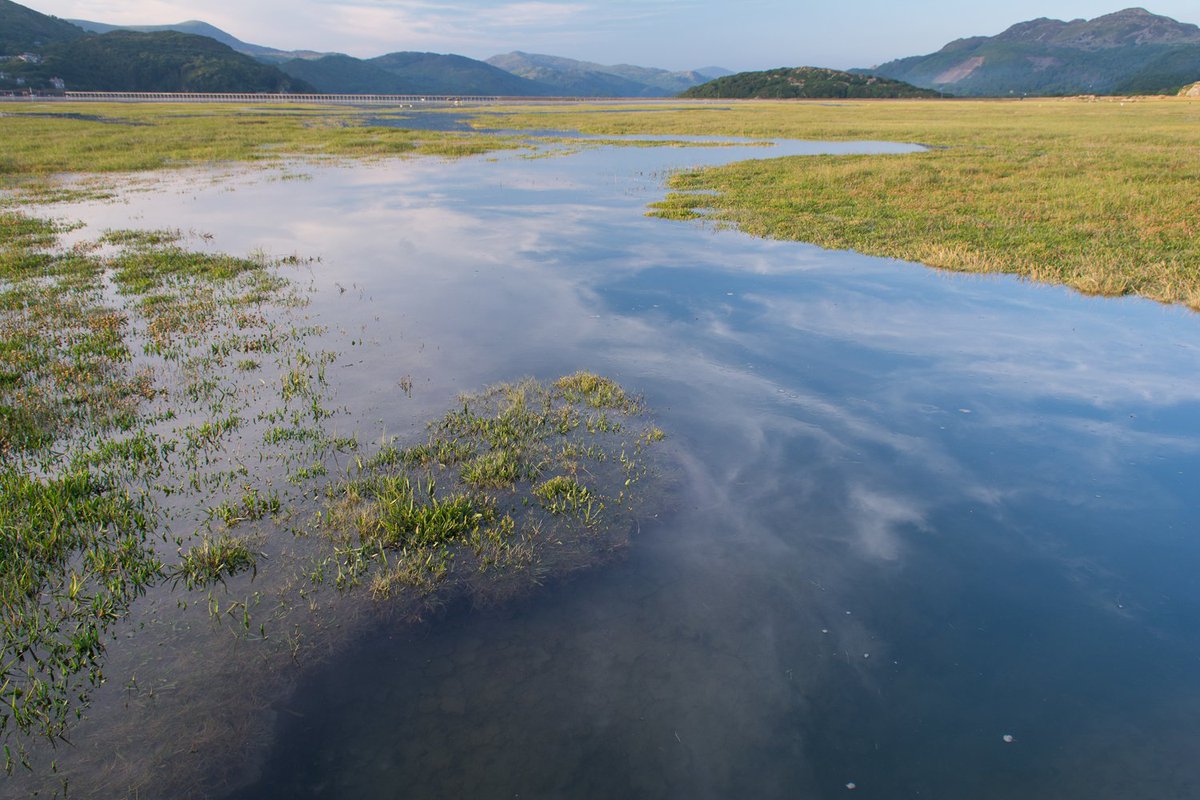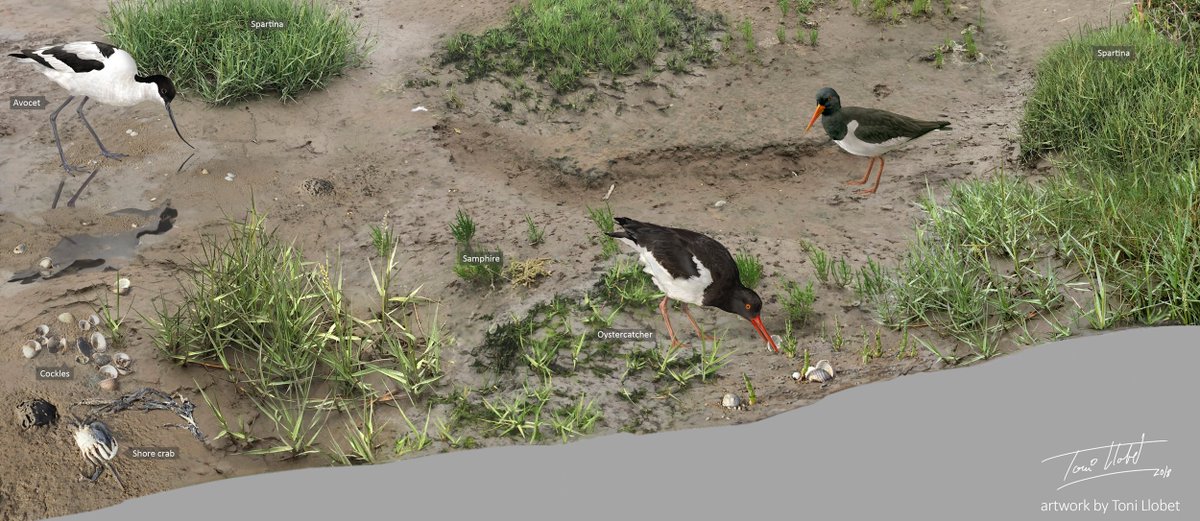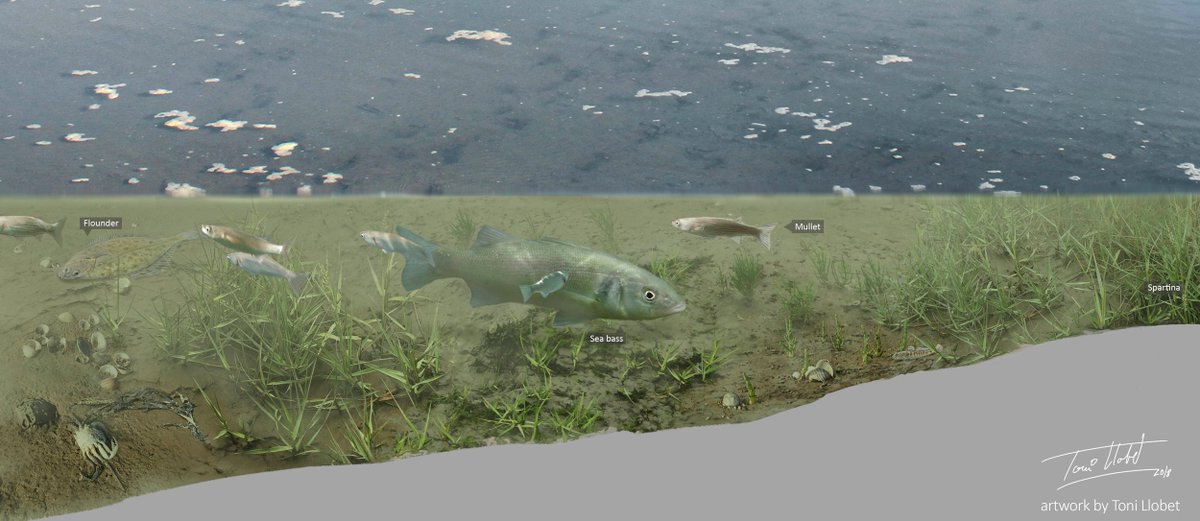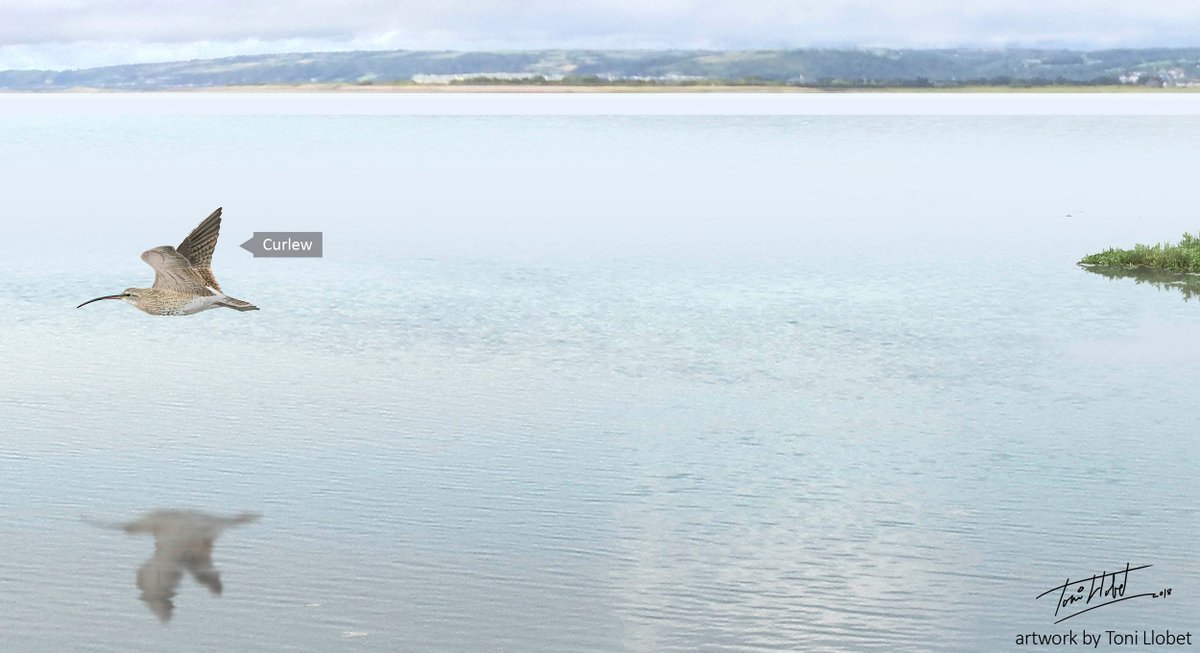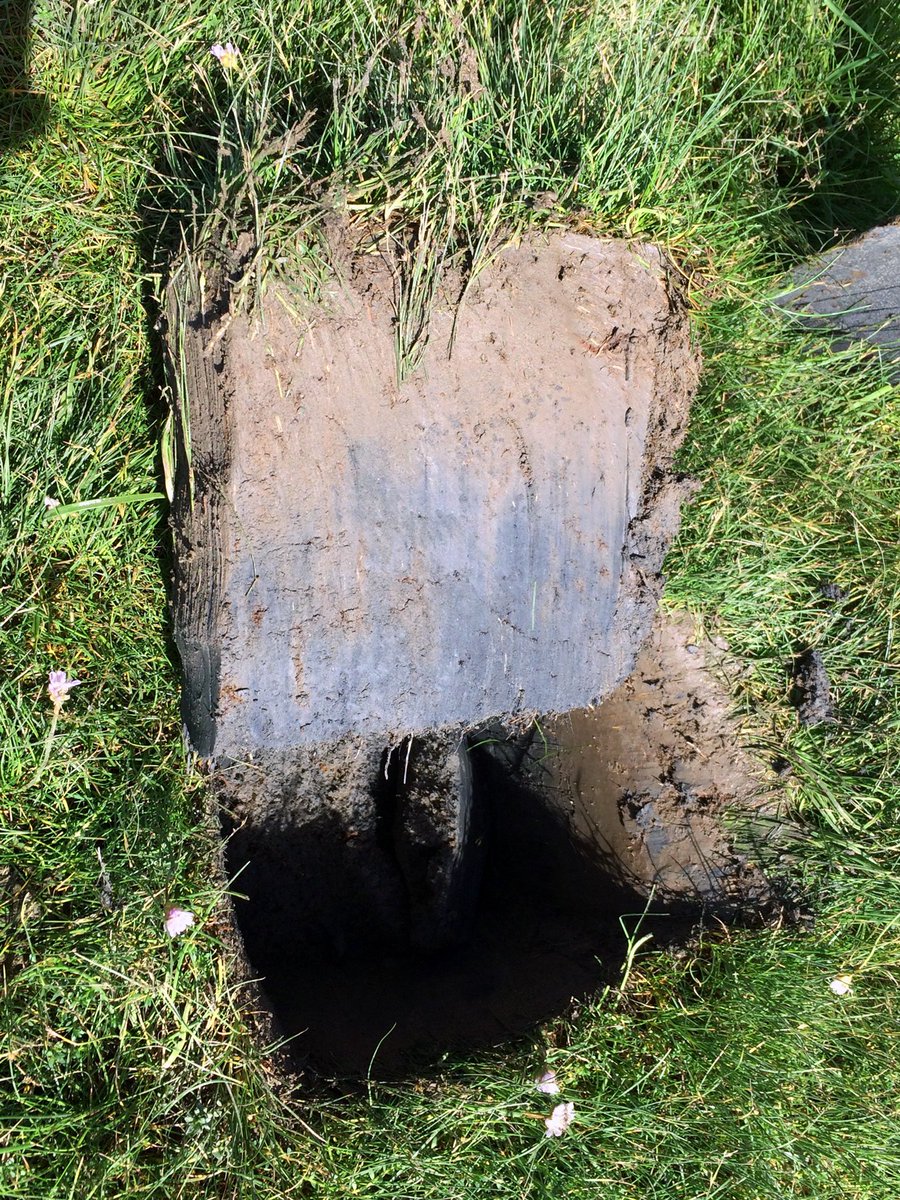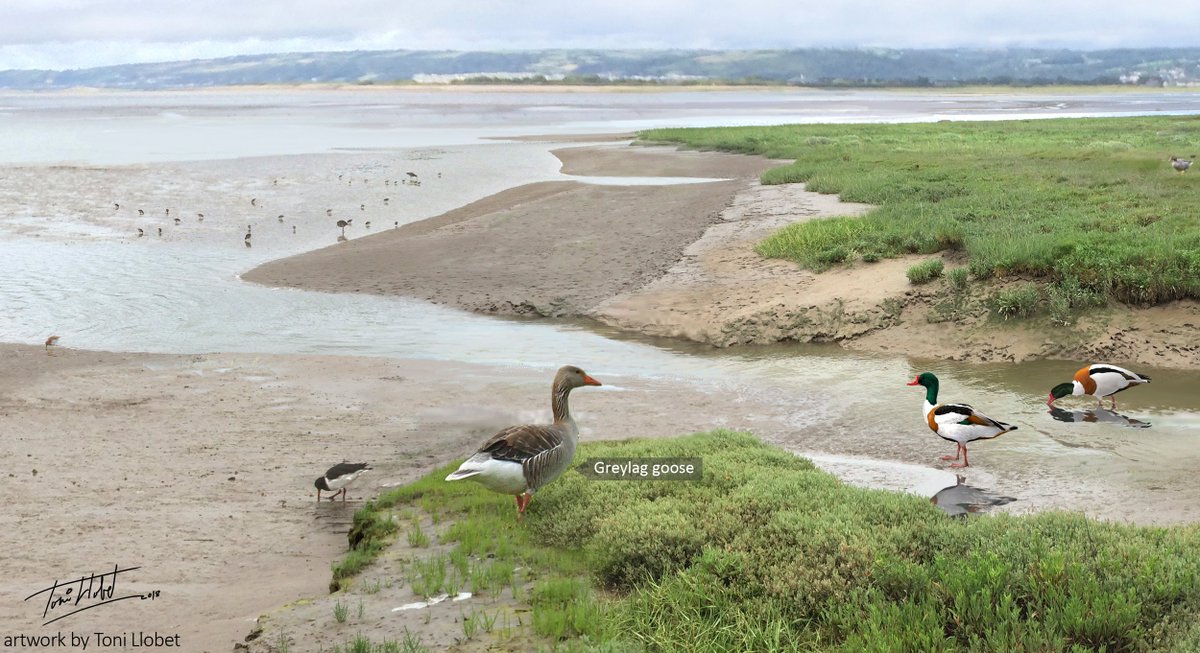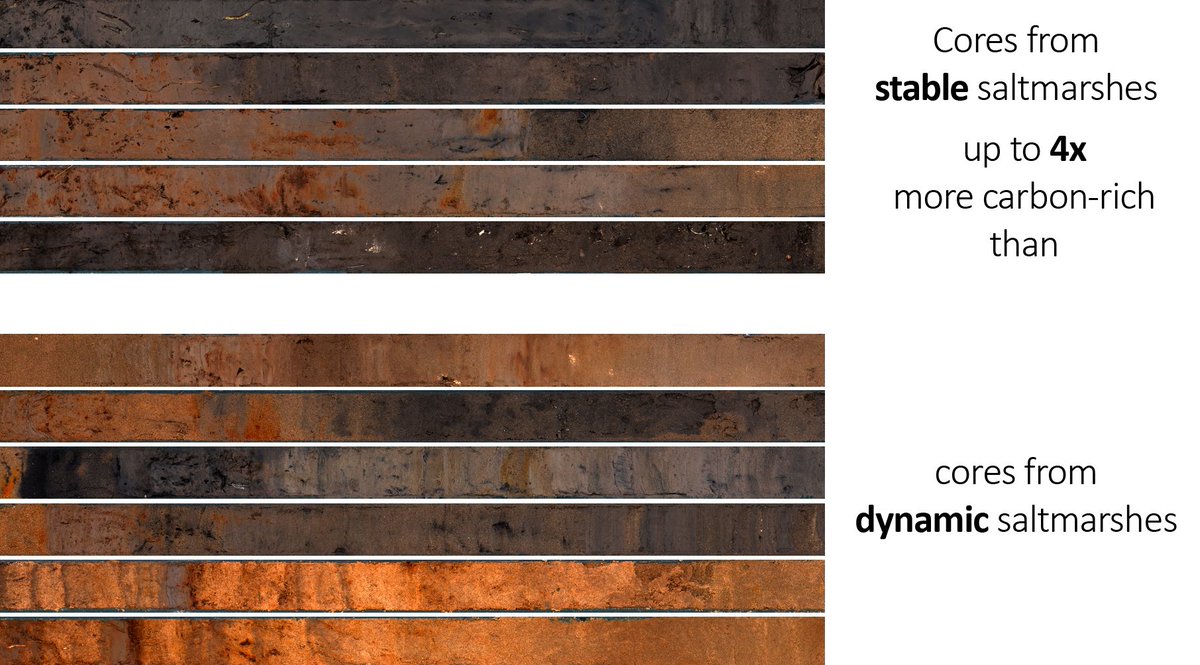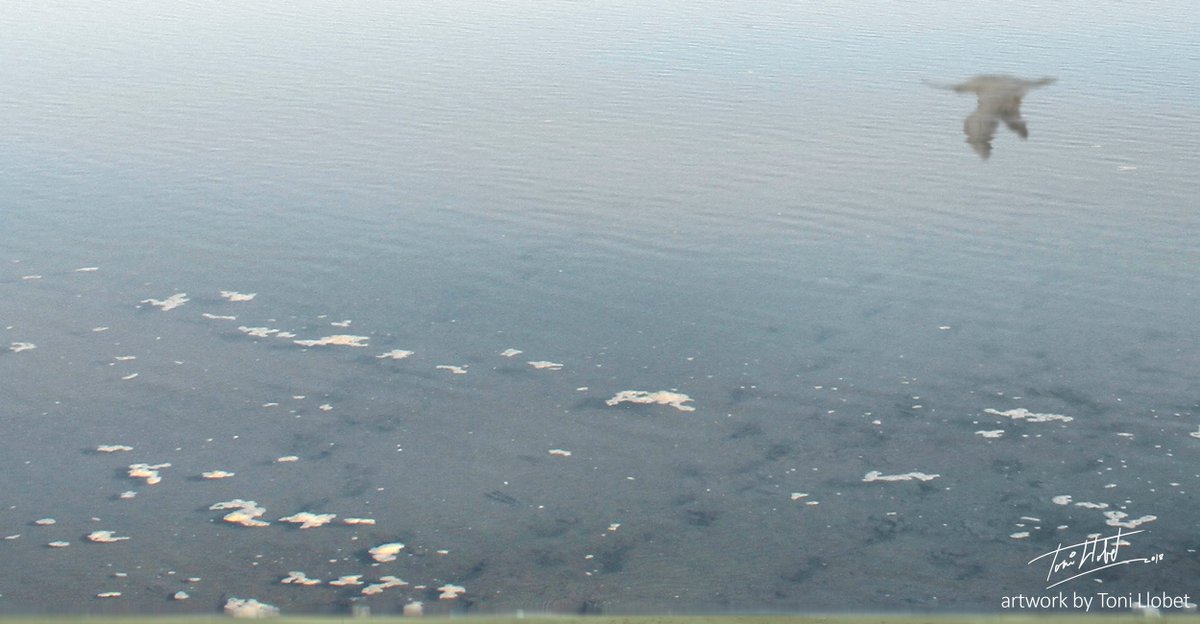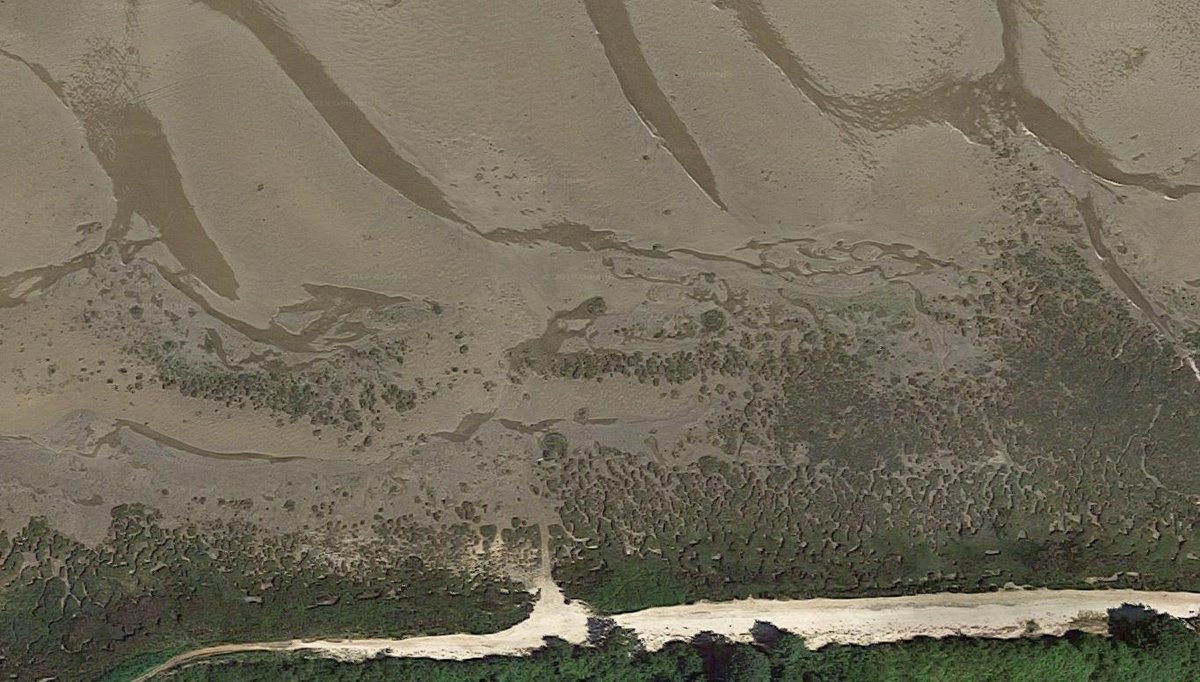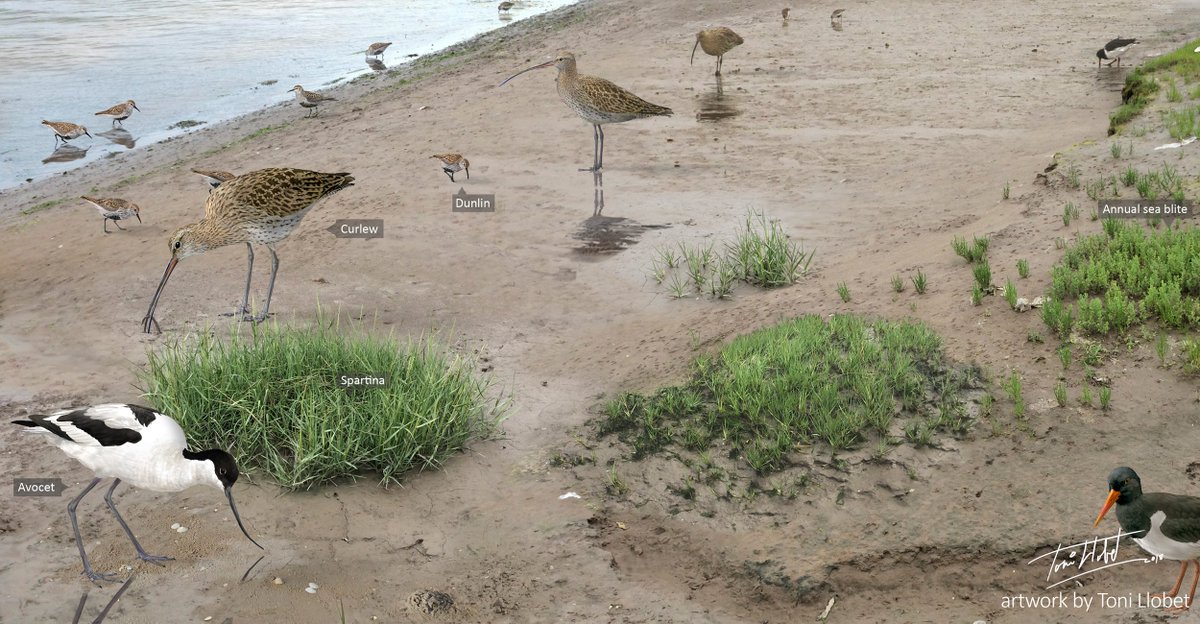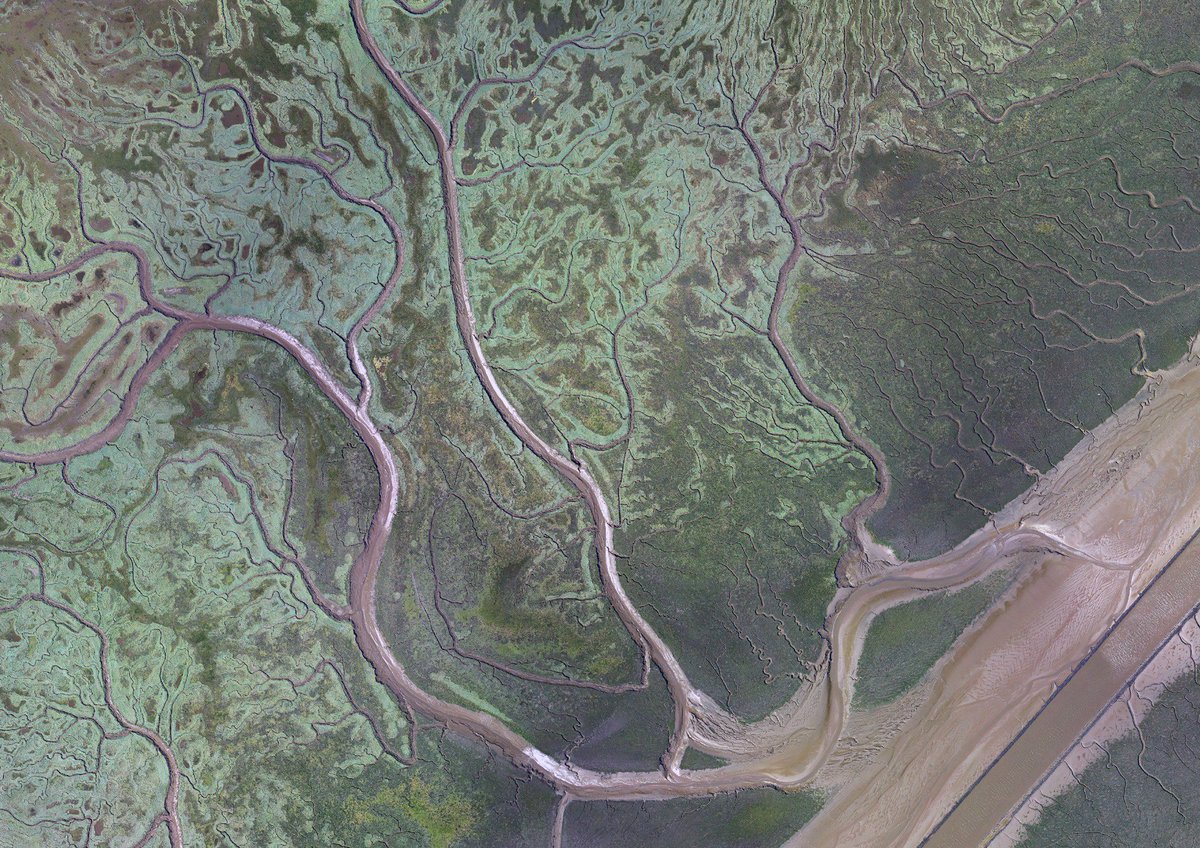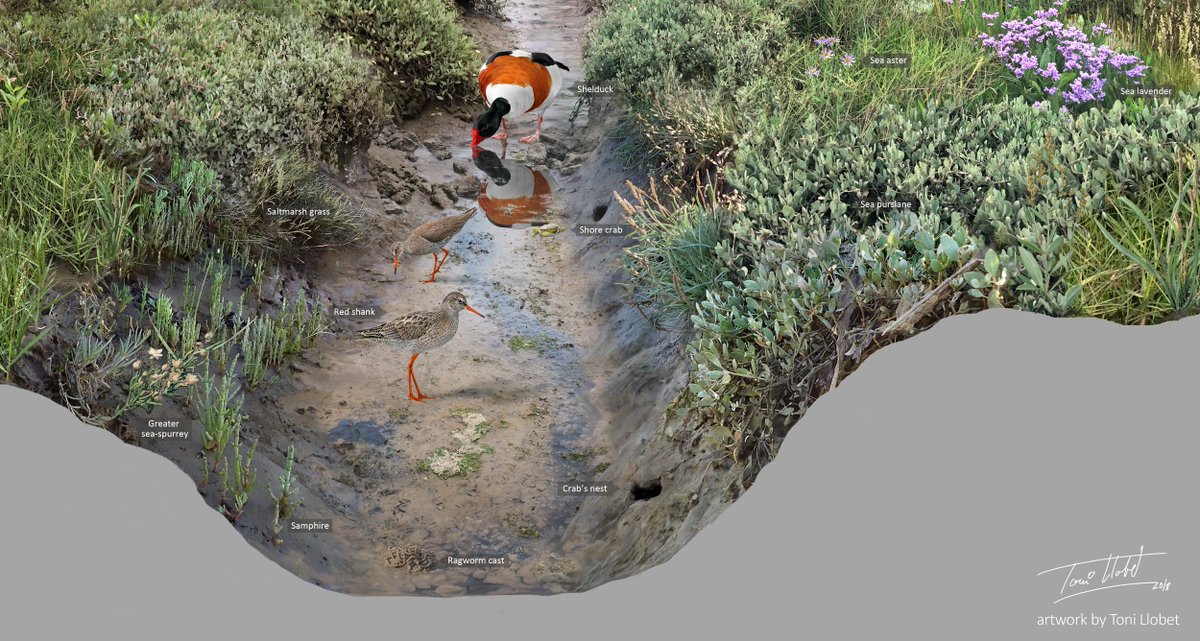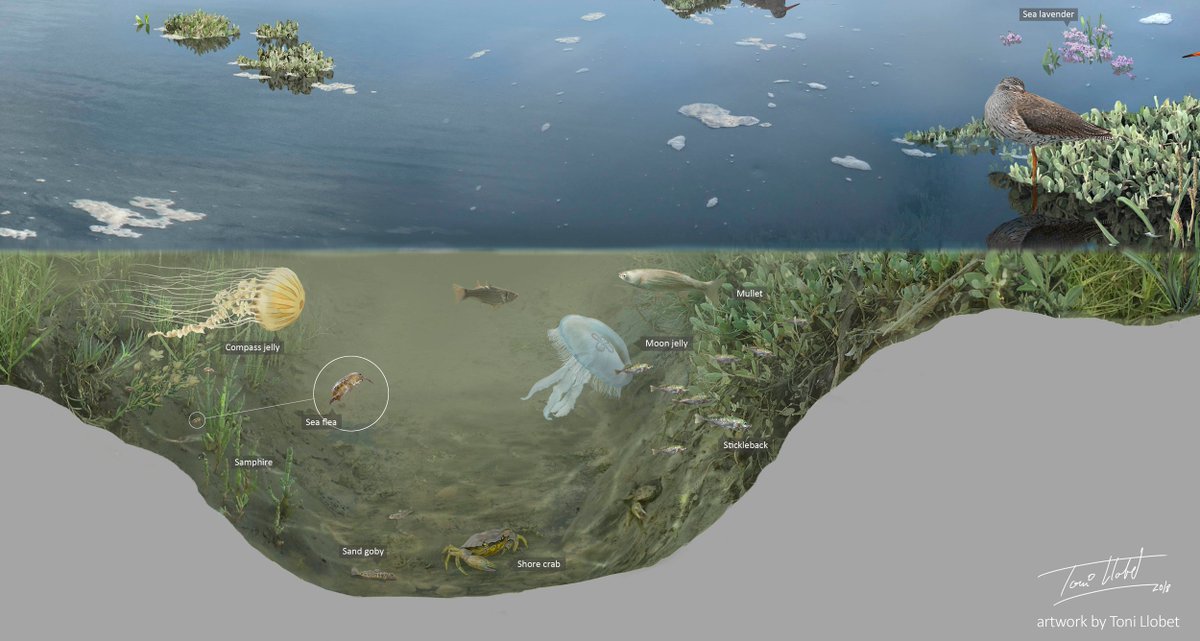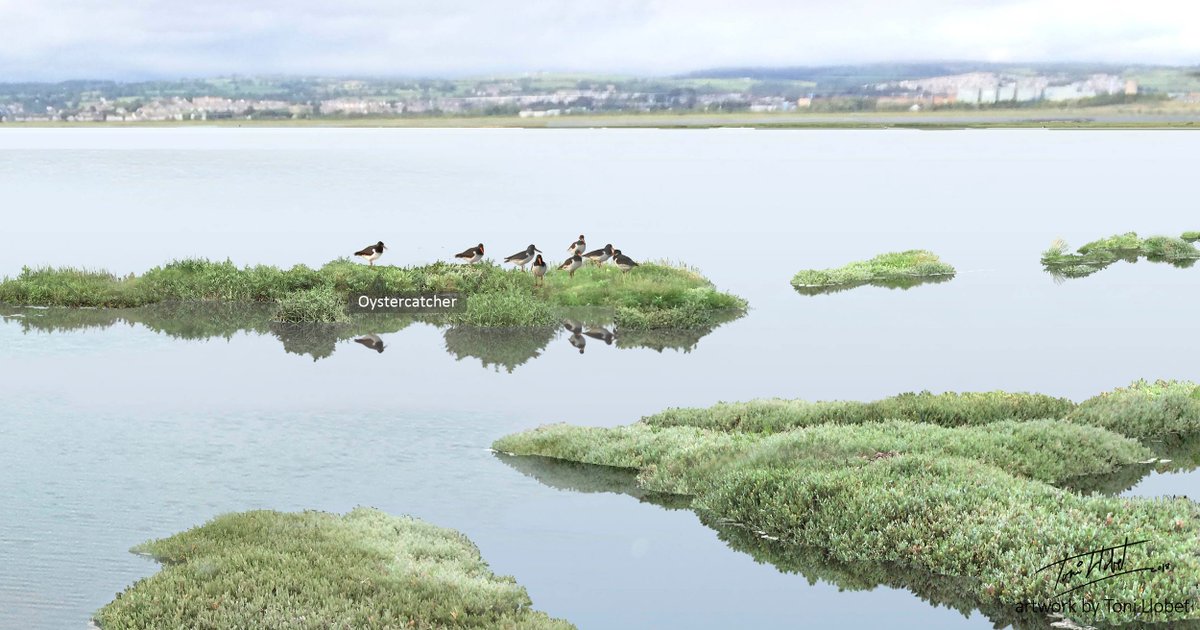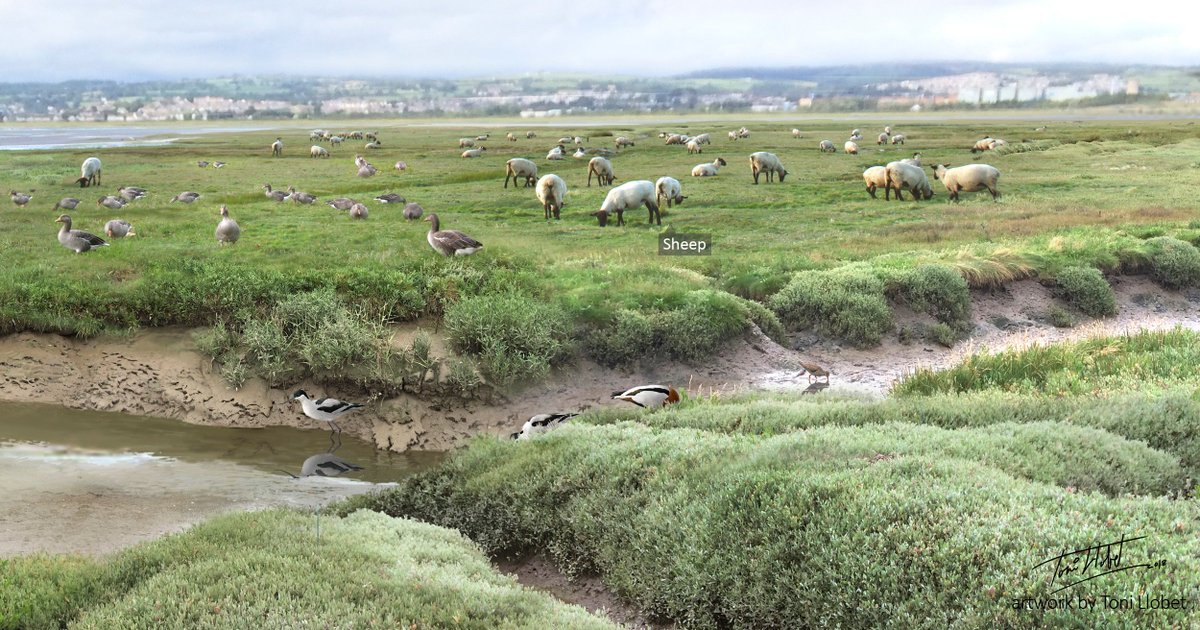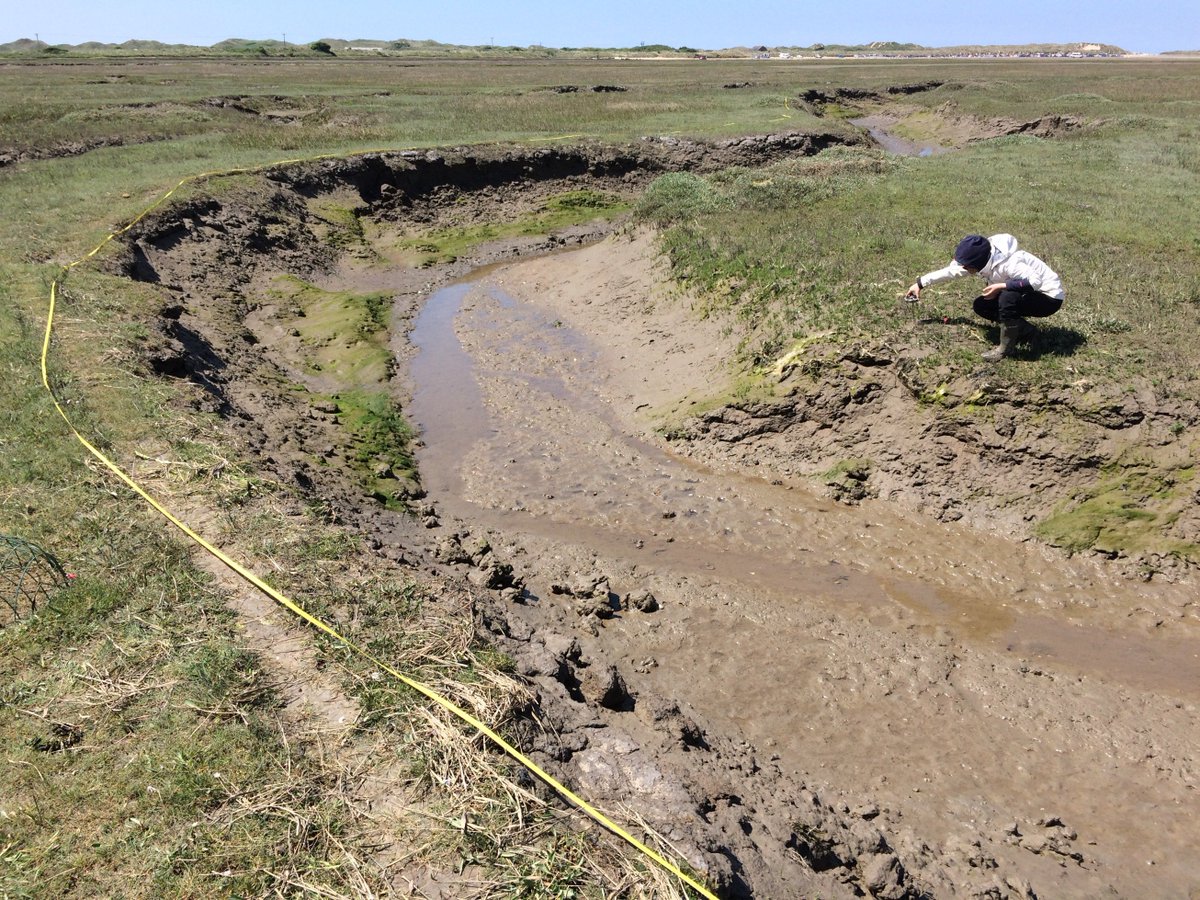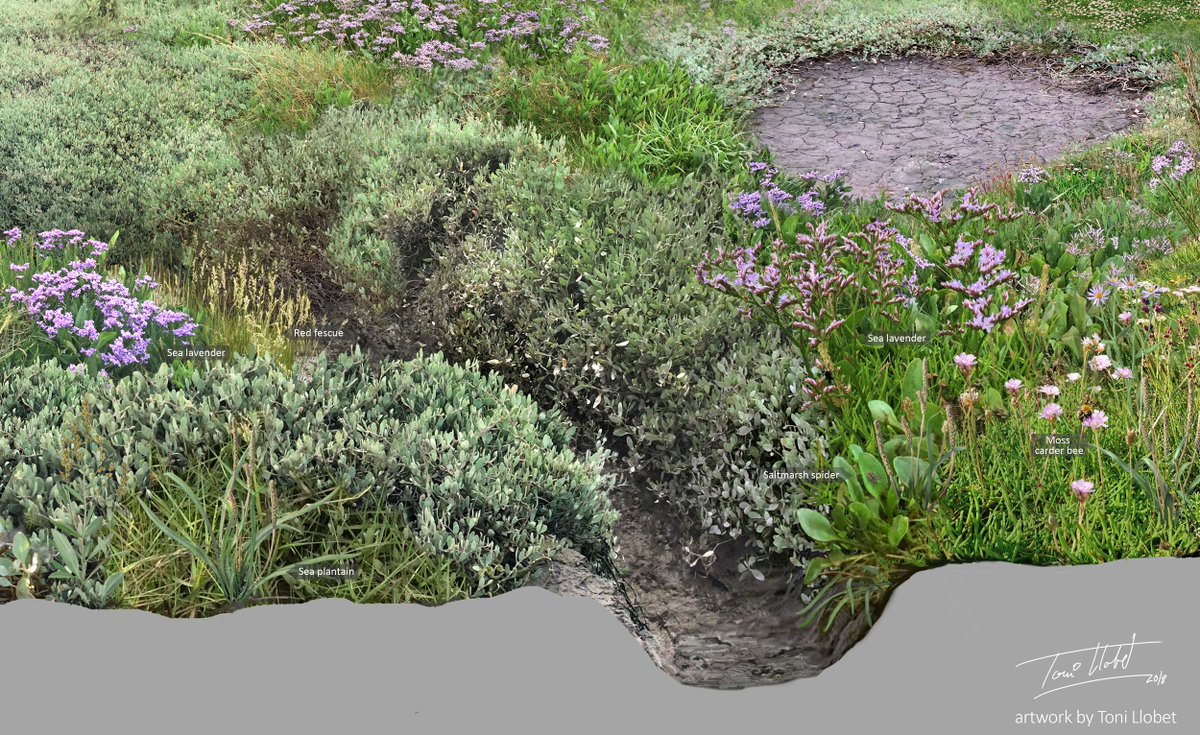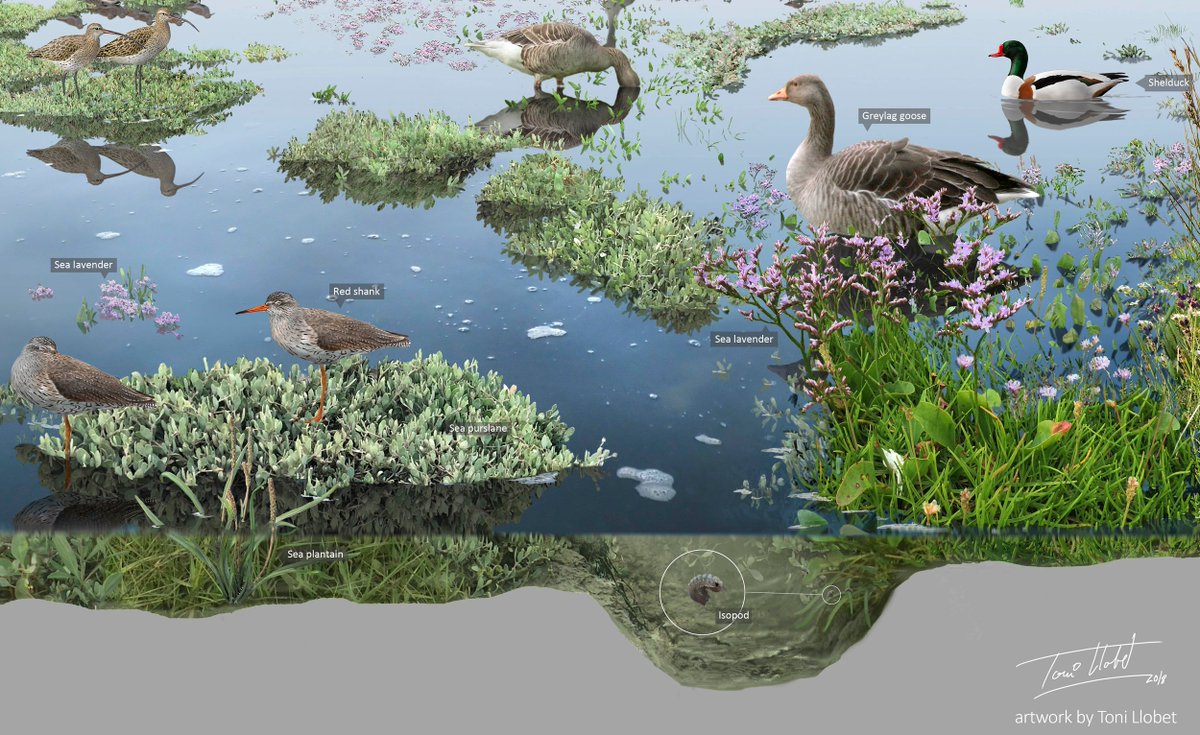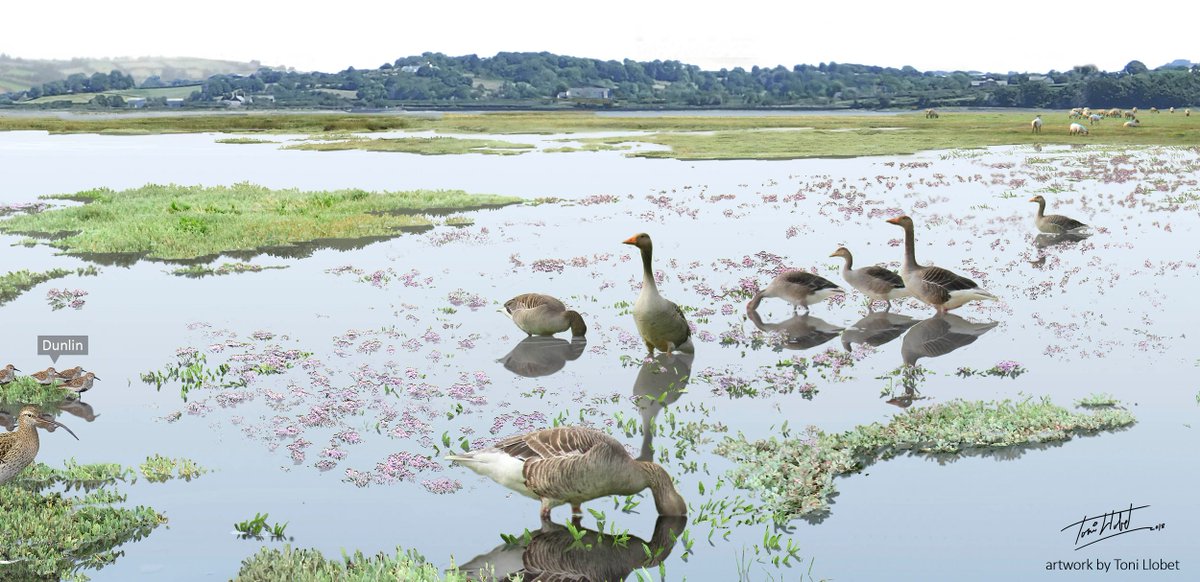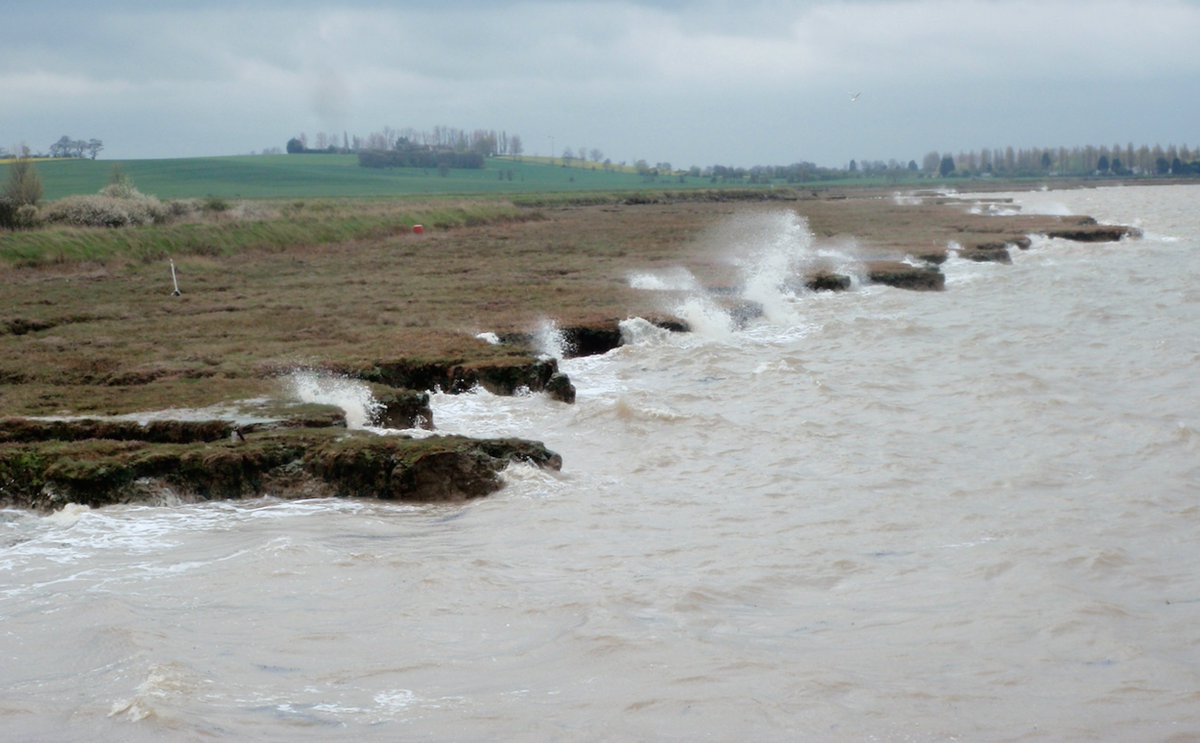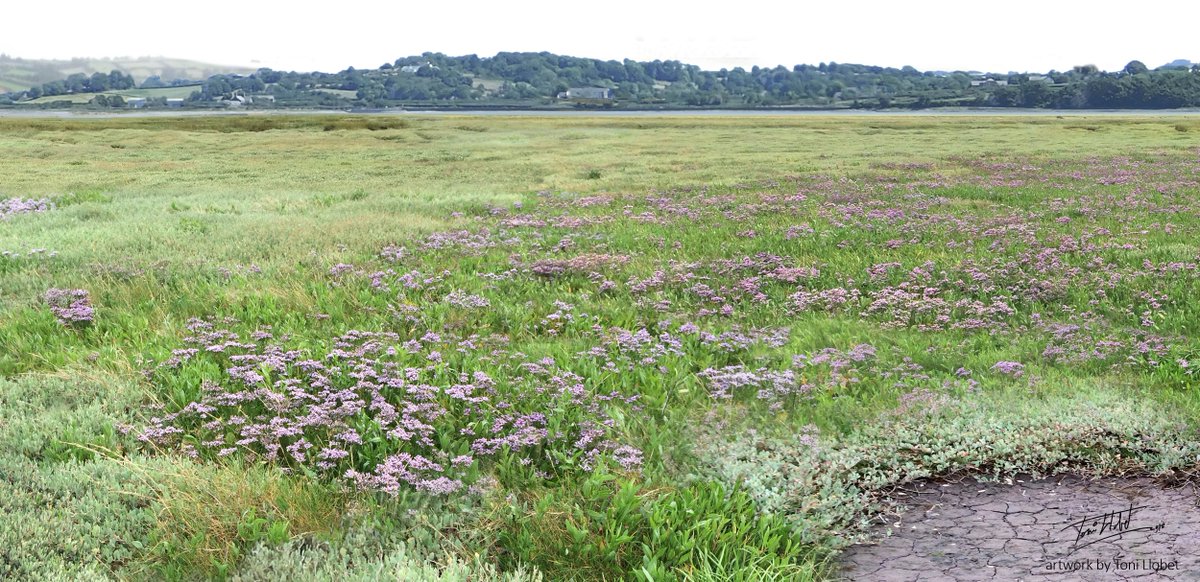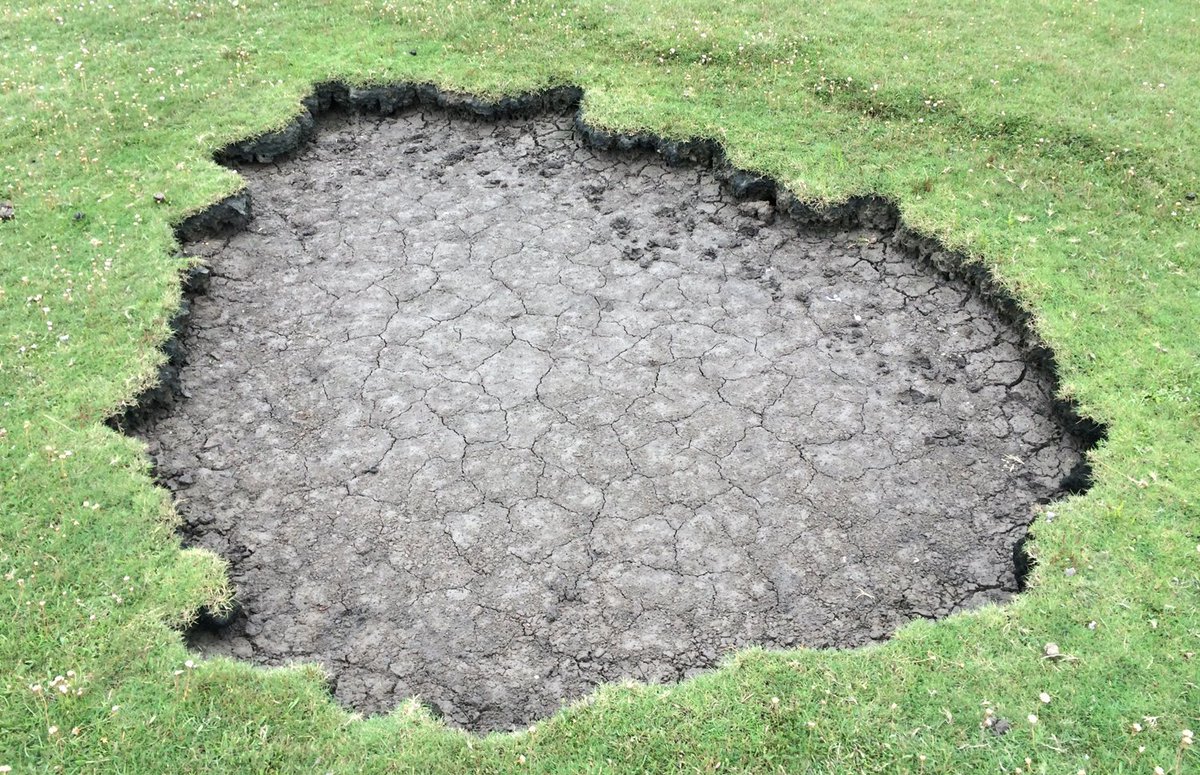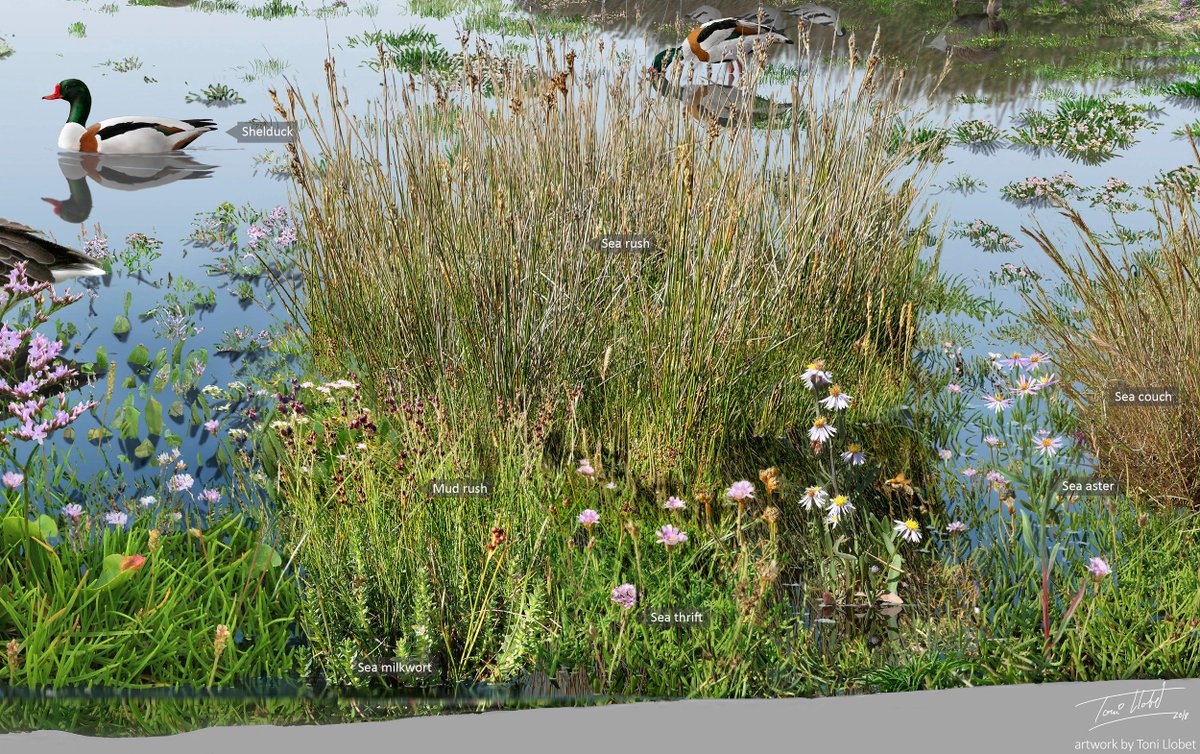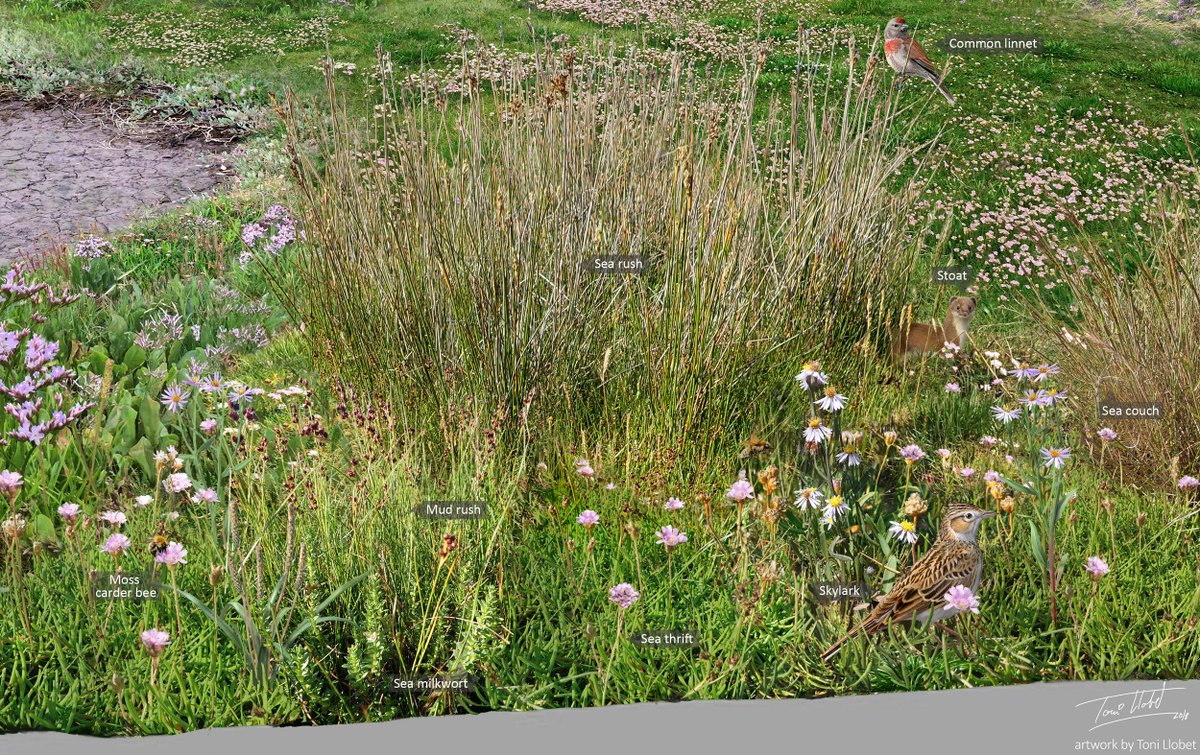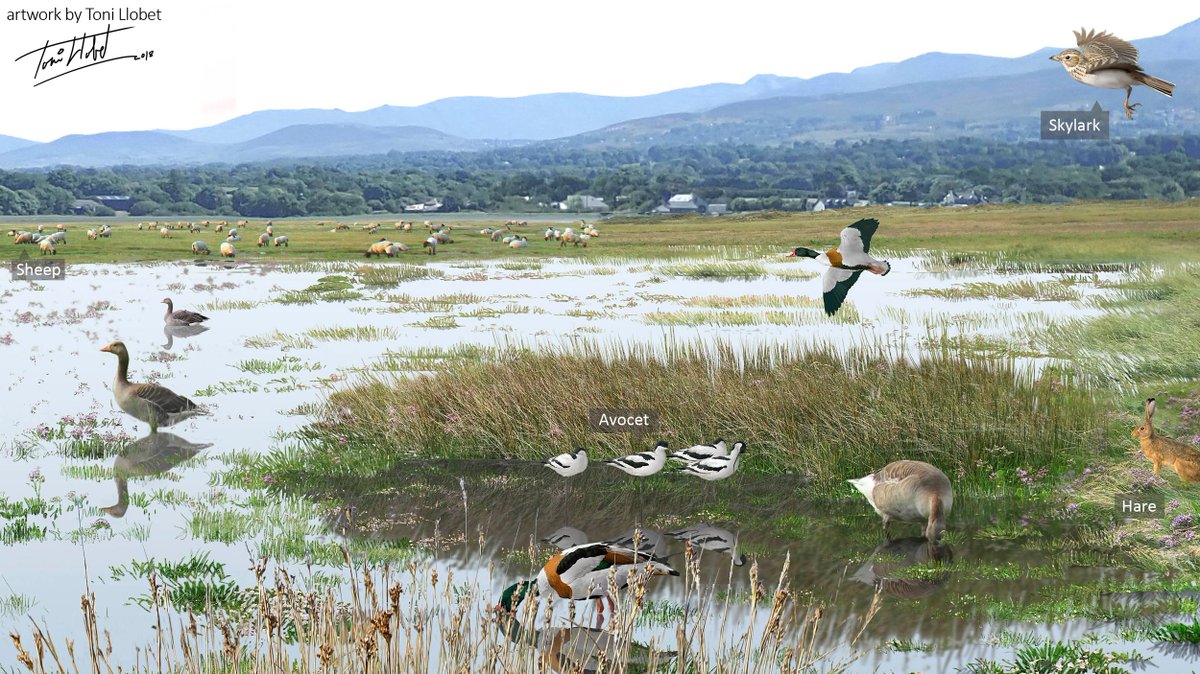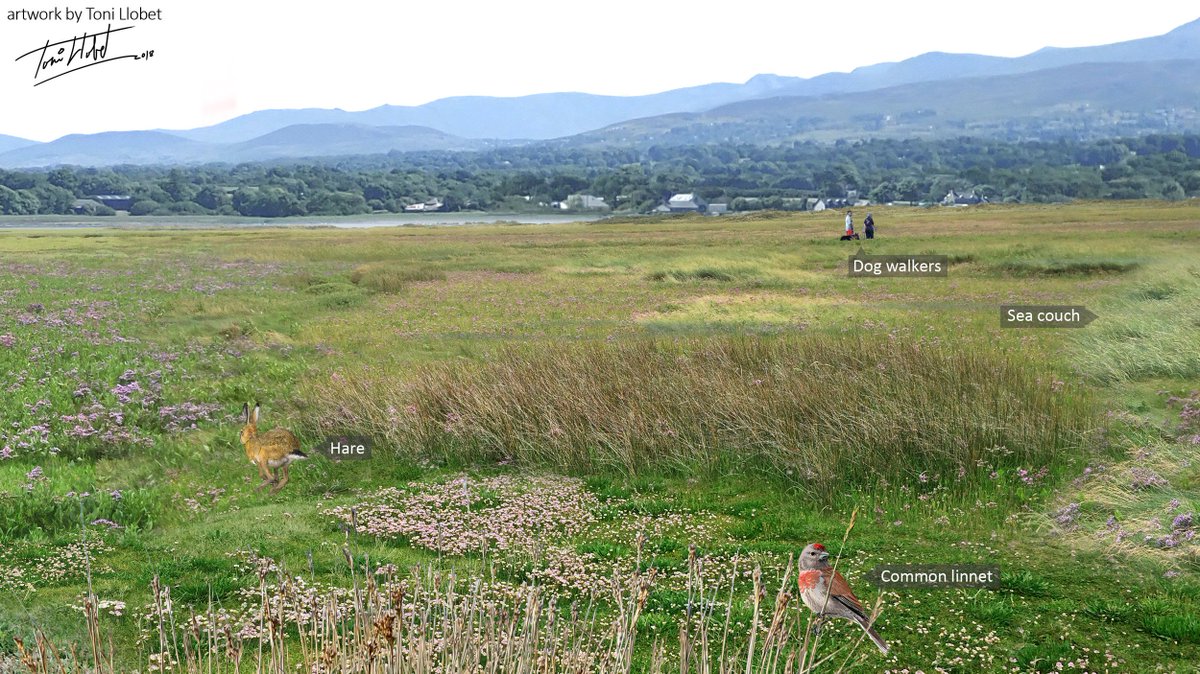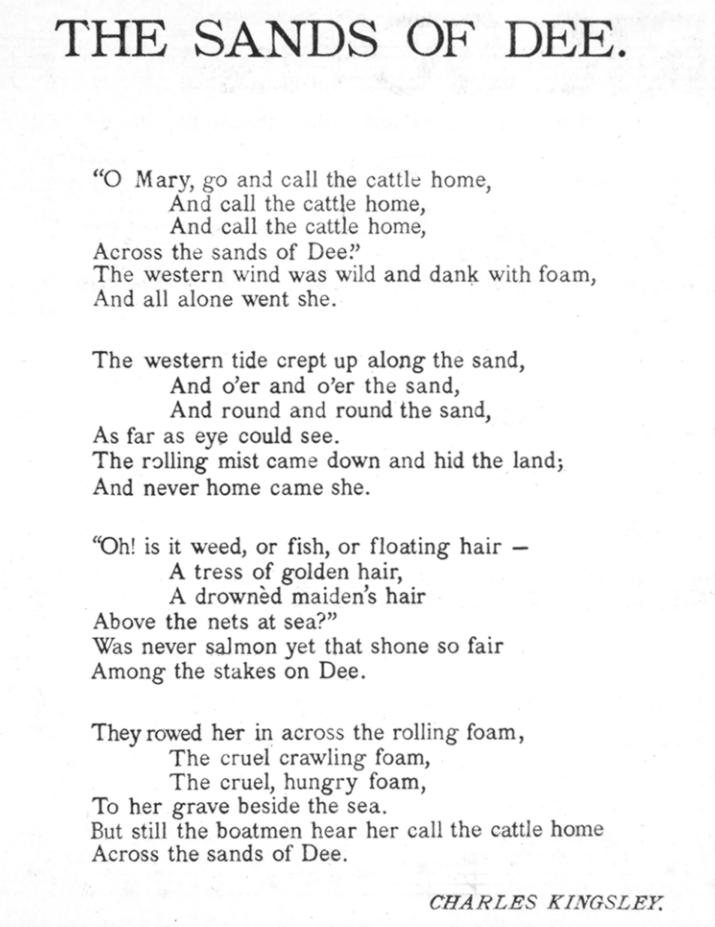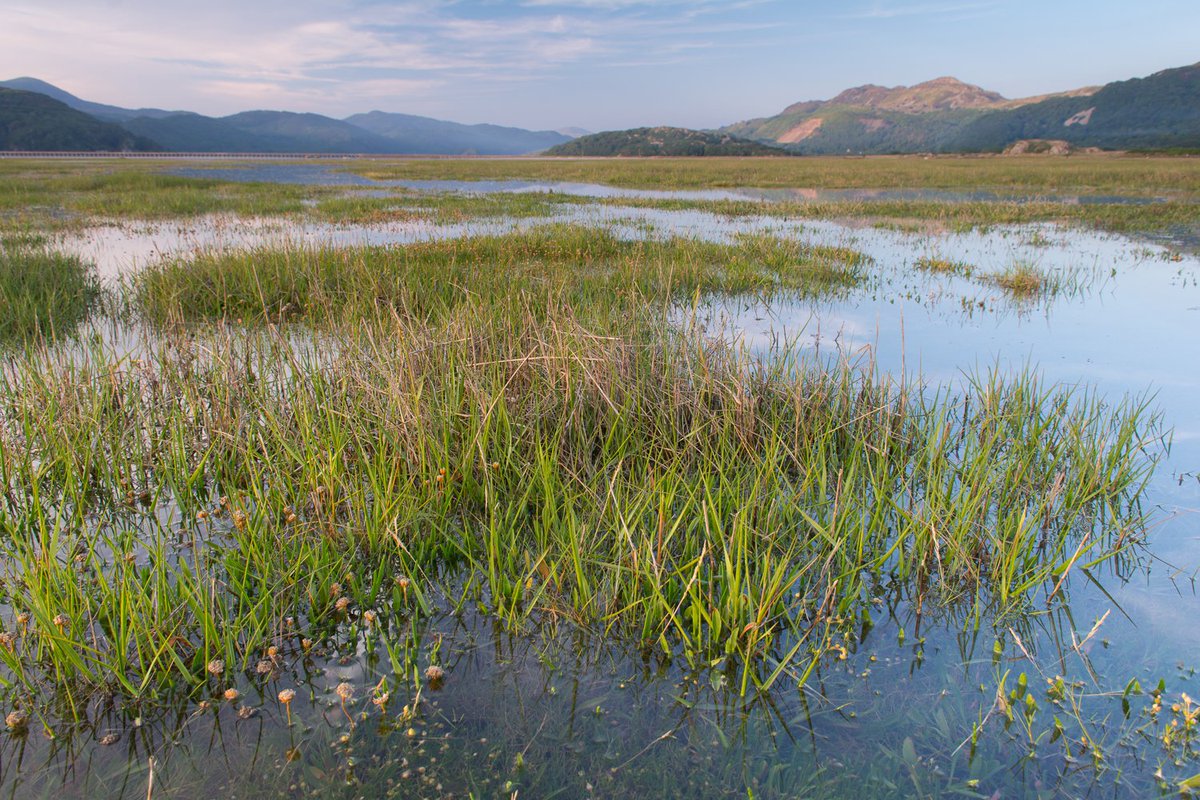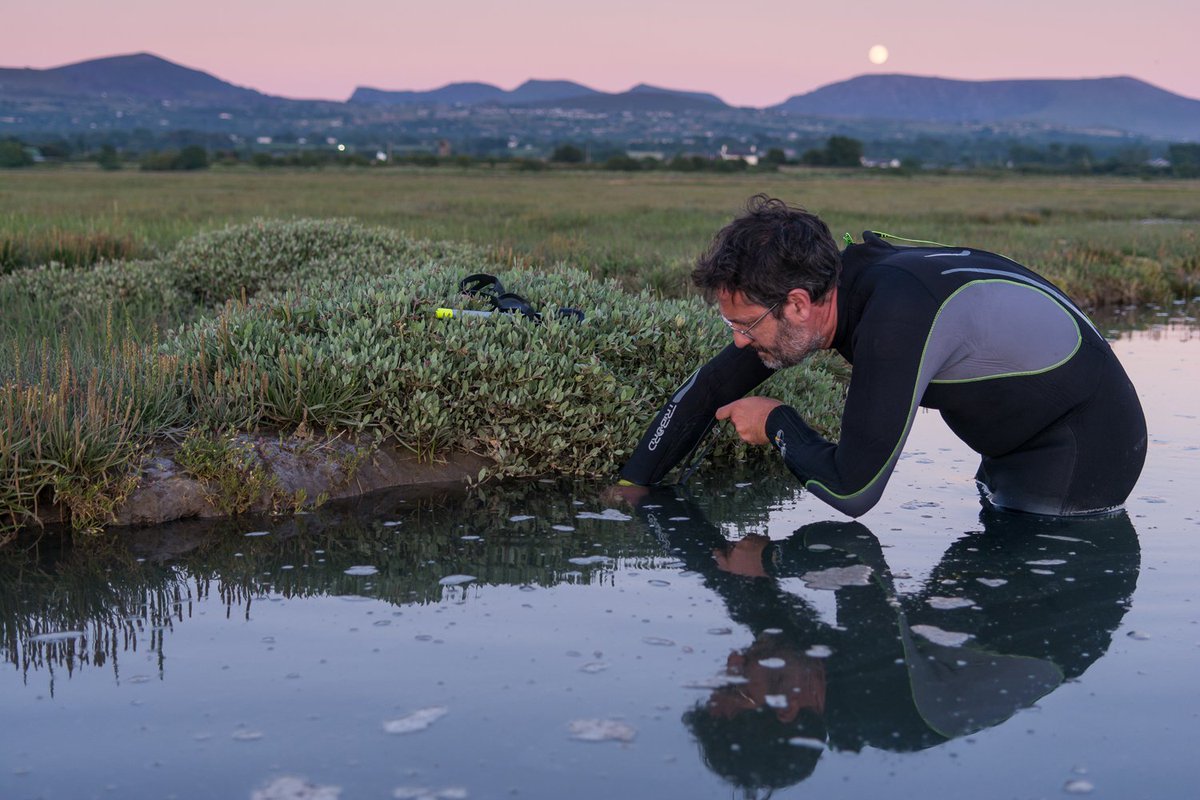#DYK that around 40% of the people that live in Wales don’t know what a #saltmarsh is, and that only 37% have ever knowingly visited these coastal environments? Despite this #saltmarshes are increasingly valued for their #ecosystemservices
We’re starting a thread to highlight the ecology of salt marshes, and how they benefit human #wellbeing. We’ll start the journey from the low marsh and we’ll move upwards until we finally uncover the full #saltmarsh #marshSTEM #Teamsaltmarsh
At the level reached by neap tides (between new and full moon), sparse cordgrass (Spartina) patches mark the transition between #mudflats & the #saltmarsh. Many invertebrates live within the sediment here & birds of all kinds have a feast at low tide. #marshSTEM #TeamSaltmarsh
Many commercially important fish species use #saltmarsh as nursery areas or for shelter during high tides, such as seabass&mullets. People enjoy foraging for wild food such as samphire or cockles in #mudflats and #saltmarsh. This can contribute to their #wellbeing @LizUnderwater
Nearest the sea, we find ‘pioneer’ plants that must tolerate water-logging & full salt water immersion. Cordgrass traps sediment & slows water movement, encouraging sediment to settle & raising the #saltmarsh platform elevation #WetlandWednesday #teamsaltmarsh
As the #saltmarsh platform rises, it buries roots, shoots & other organic matter, whose #carbon, rather than being released into the atmosphere via decomposition, gets locked away. That’s why marshes are considered efficient carbon stores, and a means to mitigate #climatechange
The seaward edge of a #saltmarsh can be quite dynamic: A gentle slope with cordgrass plants suggests the marsh is ‘progressive’ - expanding outwards (background); a marsh ending in an abrupt ‘cliff’, typically without cordgrass, is a hint that it may be eroding (foreground).
Our research shows that saltmarshes from #Welsh estuaries can be quite dynamic, sometimes eroding away and then reappearing in a cyclical manner. However, these highly dynamic marshes are less reliable carbon stores, and lock away up to 4 times less carbon than stable marshes.
The saltmarsh-mudflat transition zone is an extremely harsh environment for plants. When plant seeds arrive, they need a ‘window of opportunity’ with gentle weather and neap tides in order to germinate & grow strong roots to withstand water movement #teamsaltmarsh
At low elevations plant shoots alleviate harsh conditions for neighbouring shoots (i.e. slowing water, capturing sediment). Such a plant-plant ‘facilitation’ is key to make plant patches more resistant to waves & is responsible for the speckled look of a marsh front from above.
What type of sediment makes up the marsh is important. Muddy marshes tend to take up more space within an estuary’s intertidal zone than sandy marshes. This is important given that birds need both marsh & tidal flat environments for their nesting, resting & feeding activities.
#Saltmarsh creeks drain the marsh with each receding tide and act like blood vessels with every flooding tide, supplying the water full of sediment that the #Saltmarsh needs to keep up with #sealevelrise.
#saltmarsh creeks are home to many animal species. Crabs & polychaetes (worms) nest in the banks & bottom of creeks. Sticklebacks & mullets prey on small invertebrates that shelter in the flooded vegetation. At low tide, dry creeks are a feast for birds #ecology #teamsaltmarsh
Creek banks are hotspots of plant diversity, given that in a very short distance there’s a strong change in environmental conditions. We typically find pioneer species low in the creek, low marsh species on the creek banks and mid marsh species on the marsh platform.
The mid to low #saltmarsh, gets flooded by most high tides. Birds use the few patches that remain above water to rest, while waiting for the low tide to reveal their feeding grounds #teamsaltmarsh
Many herbivorous wild species take advantage of the #diversity of succulent & salt-rich plants that live on #saltmarshes. Geese, rabbits and hares are common. In addition, around 80% of Welsh marshes are grazed by sheep and cows #saltmarshlamb is sold as a delicacy #teamsaltmarsh
Sheep and cows have to learn to navigate this muddy & wet environment, and to move to higher ground when the tide comes in. Farmers commonly lose livestock when there are storms and very high tides #saltmarsh #agriculture #teamsaltmarsh #ecosystemservices
Given their heavy bodies & small feet, sheep & cows compact the #saltmarsh soil, which can make grazed marshes more stable, & less prone to erosion. However, in great densities, animals might actually have the opposite effect by increasing erosion of creek edges #Teamsaltmarsh
The mid #saltmarsh is lush green & colourful during the summer. Sea lavender & aster are in full bloom, which attracts #pollinators, such as #bumblebees & #honeybees. It is also in summer when saltmarsh spiders are busiest hunting insects #teamsaltmarsh #ecosystemservices
When we look at a #saltmarsh in full bloom, it's easy to forget that it is a #marine habitat & when the tide floods the marsh, insects have to either fly away or climb to the highest stems. Some spiders don't even flee but thanks to special hairs, just float away #amazingnature
During high tide, sheep can only graze on the highest grounds. The rest of the marsh is flooded & only long-necked birds, such as geese, can graze on the flooded meadows. Indeed, most UK marshes can get completely flooded during spring tides, and even more during storm surges
When covered by water during a #storm #surge, the plant cover and bumpy surface of #saltmarshes causes waves to lose at least 15% of their height over a distance of only 40m, acting as a #nature-based solution for #floodriskmanagement https://www.cam.ac.uk/research/news/salt-marsh-plants-key-to-reducing-coastal-erosion-and-flooding (Photo @JA_Tempest)
Saltmarshes are sculpted by the sea, directly, especially when it’s rough, but also in subtler ways, as in inducing plant ‘zonation’. In the image, salt tolerant species such as sea-purslane&saltmarsh grass, leave way to a mid-marsh full of sea lavender&sea thrift #amazingnature
Such clear zonation patterns might get interrupted by creeks or salt pans. The formation of salt pans is a bit of a mystery. Some authors claim they are old creeks that became disconnected. Others, suggest that pans are the result of the way the marsh was colonised initially
At higher elevations the diversity of plant species goes up. The first sea rushes appear, as well as the sea couch that marks the start of the high marsh. This area only gets flooded by the highest spring tides, especially in autumn and spring.
Among the tall rushes, the redshank nests, and the hares run. The bumblebees buzz and the birds sing. The marine ecosystem is gradually giving way to a more terrestrial ecosystem, with less salt-tolerant plants and more land mammals and insects.
The upper marsh is the area most used by people. Still, in a recent survey, only a third of respondents had ever knowingly visited a saltmarsh. Among those that had been in a marsh, they had mainly visited to ‘enjoy the views’, ‘go walking’, ‘dog walking’ or ‘birdwatching’.
Being at the fringe between land & sea, makes saltmarshes particularly biodiverse habitats. Biodiversity can drive human interest & may even improve visitors’ mood. Also, environments with water have been shown to promote self-esteem, positive mood and relaxation. #wellbeing
Our recent survey shows that people that hadn’t visited a marsh said they hadn’t done so mainly because they ‘preferred other habitats’, were ‘not interested’, or because they found marshes ‘inaccessible’, too ‘muddy’ or ‘dangerous’.
Indeed, saltmarshes have long been perceived as challenging, treacherous and mysterious environments. They have even inspired dark poems such as ‘The Sands of Dee’ by Charles Kingsley.
#Saltmarshes are among the most changing natural landscapes you can find in the UK. At the fringe between land and sea, they can be seen as fully marine habitats, when fully submerged by spring tides, with their creeks gleaming with jellies, mullets and crabs...
… Or they can be seen as lush green, blooming meadows where sheep graze, hares run, birds nest and dog-walkers walk by. It is this fringing position between land and sea, and the #ecosystemservices they provide that make saltmarshes so interesting and valuable!
If you want to know more about salt marshes, follow @coastwellbeing & @RESILCOAST. Can you think of any more benefits provided by #saltmarshes? Share your views in the replies!
Many thanks to the amazing artist @tonixllobet that made these illustrations possible (see him working on location), and thanks to @ValuingN and @NRNLCEE for funding @coastwellbeing and @RESILCOAST projects.
If you are a local council, @NatResWales or @EnvAgency officer, @nationaltrust @Natures_Voice or @WildlifeTrusts nature reserve manager, etc. and you would like to discuss how to use these illustrations, please direct-message us @coastwellbeing.

 Read on Twitter
Read on Twitter